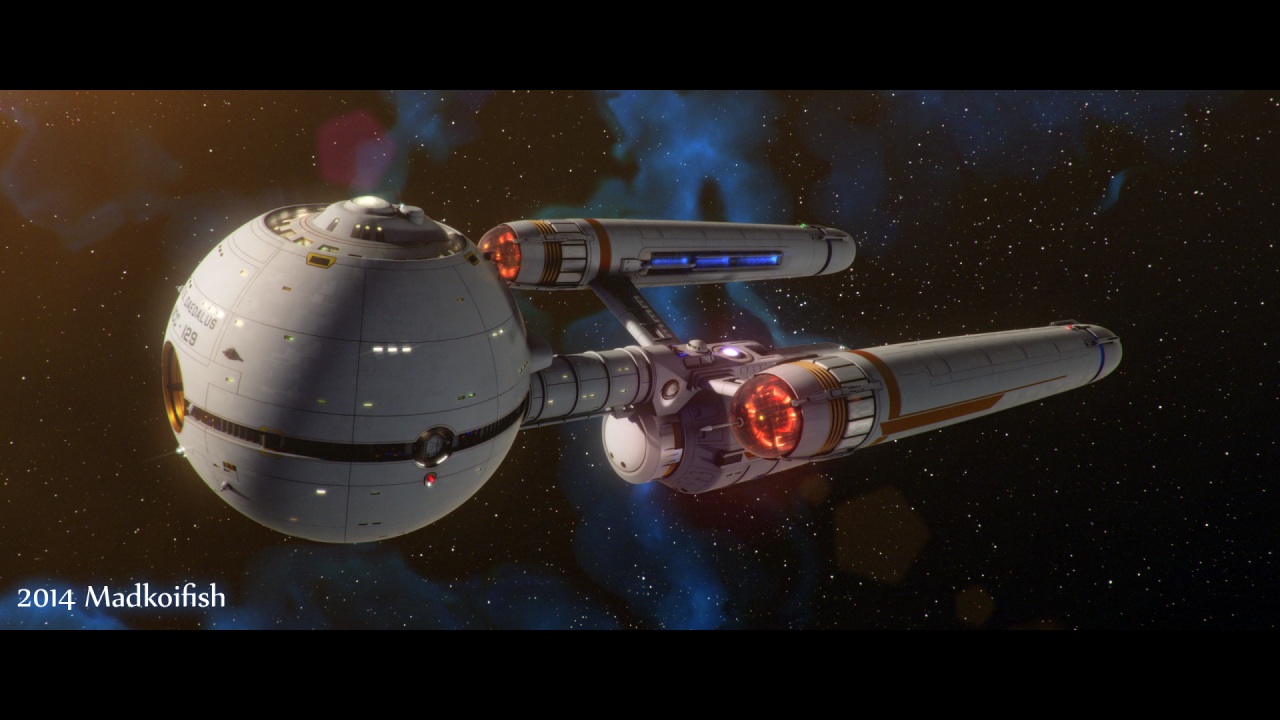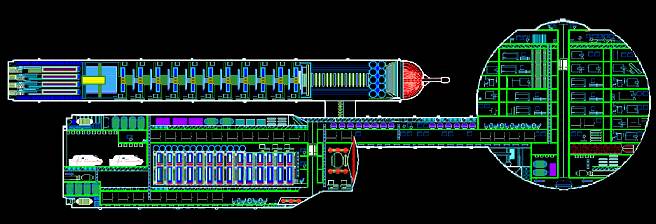Daedalus Class

| |
| Daedalus Class | |
| Information | |
| Affiliation | |
| Role |
Cruiser |
| Service | |
| Operator | |
| Entered Service |
2116 |
| Endurance | |
| Expected Design Life |
70 Years |
| Expected Refit Cycle |
5 Years |
| Expected Resupply Cycle |
9 Months |
| Crew Capacity | |
| Standard Complement |
94 |
| Emergency Capacity |
200 |
| Dimensions | |
| Length |
121 meters |
| Width |
48 meters |
| Height |
40 meters |
| Decks |
10 |
| Propulsion | |
| Propulsion Systems |
Matter/Antimatter powered warp drive |
| Cruise Speed |
Warp 2.5 |
| Maximum Speed |
Warp 3 |
| Emergency Speed |
Warp 3.5 |
| Armaments | |
| Energy Weapons |
|
| Torpedo Launchers |
|
| Torpedo Payload |
|
| Shields |
Hull Polarisation System |
| Small Craft | |
| Shuttlebays |
1 |
| Shuttles |
2 |

| |
| Template:Specification | |
The NCC-class starship, originally designated the NC-class and later referred to as the Daedalus-class, was created and operated under the command and control of United Earth’s Starfleet. This class of ship was part of a multi-research, design and development programme orchestrated by the United Earth Space Probe Agency (UESPA) and Starfleet in the 2110s. It was to replace the aging NA-class (Emmette-class) and fill the gap left by the older design from the DY-class ships. The design would go on to be one of four classes Starfleet wanted to use to create a modern workhorse.
Exploration and Science
Originally not geared for deep space exploration, the Daedalus-class was outfitted with a handful of basic laboratories that were modular in design and could be reconfigured easily with basic reliable equipment by the crew on a mission basis’ need.
Again, like it’s other equipment the sensor array is a simple dependable system that is more geared towards helping this class with its work in patrolling and supporting the development of the emerging United Earth Commonwealth.
Only a dozen rudimentary probes are placed on this class and these probes must be dropped into space, instead of being fired from torpedo launchers.
Diplomacy
Not designed for any large state dinners or VIP guests, the Daedalus-class has limited facilities to host guests besides its modest shared quarters. The crews of these ships often compare the guest cabins to hostels, where communal sharing takes place.
Engineering
The original warp two engine over the years has received numerous upgrades, allowing the ship to sustain a respectable warp three point five for a few hours. The plasma injectors are not designed to take the ship any faster than this.
The ship’s systems are handled by a computer system that was originally designed in the 2110s and over the years has been upgraded with enhanced operating systems and some hardware improvements. Only in 2145 was the computer core replaced by an entirely new system, one that was still reliable but faster in performance.
The ships have large cargo bay space, these can be converted to not just store cargo but can be used as additional rooms for crew and guests or extra space for the limited sickbay.
Tactical
One of the several classes to be outfitted with the new hull polarisation system, the Daedalus-class is able to hold its own in a battle for some time, however due to the lack of power compared to its newer cousins, these ships are best to remain together in packs to survive.
At the start of its service, the Daedalus-class was outfitted with two forward plasma pulse cannons, one aft rotating plasma cannon along with two spatial torpedo launchers (one forward and one aft). The ship is also equipped with a singular grappler. In the 2150s, these systems were replaced with pulse phase cannons (four forward and four aft) and four photonic torpedo launchers (two aft and two forward). The additional weapon ports took up valuable cargo bay space though.
Shipboard life
Not the most luxurious ship to serve on, the crew amenities on the vessel are sparse and these ships are the ones that truly bond a crew together in a close-knit community. Everyone shares a cabin with at least one other, besides the captain.
The mess hall is the only designated area for recreation activities, as such not only do the crew eat here but entertainment activities/events take place. Being the chef and morale officer on one of these ships is a challenge. One aspect that this class does well in is the use of its hydroponics bay in growing the crew’s own vegetables. To keep themselves fit, crews normally make their own gyms in the cargo bays or find other ways of keeping fit.
To access most decks, the crew must rely on one lift that moves up and down in one shaft in the center of the primary hull. Stairs, ladders and having to walk from one end to the other is the only way to move around.
Sickbay is a small area, allowing for four examination beds and a smaller area for surgery.
Class History
Initially the class was designated the NC-class and its conception started in the mid-2110s. The need for this class was based on discussions from a select committee of the United Earth Parliament based on the notion that with the United Earth Commonwealth expanding its colonies Starfleet needed to have a fleet that would protect, assist and supply these new settlements. At the time the idea was floated around that Starfleet may be seen as the modern-day space coastal guard for Earth and its colonies while continuing its work of exploration with the UESPA. It was also hoped that an increase in Starfleet ships present within what was designated the Home Territories (the sector of space that encompassed the Sol, Alpha Centauri and Vega systems with other Earth nearby colonies) would encourage more people to travel as they would feel safe and assured.
When the designers, researchers and engineers gathered in Japan’s capital city of Tokyo, the home of Starfleet Research and Development, they were giving the brief to come up with a handful of designs that used current reliable technology and were economical to build in a short amount of time. By the end of the month the designers returned with five classes of ship; the Daedalus-class, the Ganges-class, the Sarajevo-class, and the Freedom-class. Their thinking behind their designs was to provide Starfleet with ships of different sizes and abilities which would create a workhorse fleet that was adaptable and resourceful. This was exactly what Starfleet wanted and what the government had wished for. The plans were approved to start construction of each class’s prototype as soon as it was feasible.
Being estimated as the cheapest and easiest design to assemble, in mid-2115 the NC-class began construction in orbit of Earth. The ship would be outfitted with a warp drive being able to achieve warp two point five. The unusual shape of the class was one of uncertainty among some members of the top brass, in particular the spherical shaped primary section. Unlike the other classes that had opted for more streamlined shapes, the Daedalus-class was considered the odd child being constructed. However the simplistic designs of a spherical primary section attached to a cylinder shaped secondary hull was what made it cheaper to produce. The basic design allowed for more space to be assigned to storage for cargo, passengers and for the first time a hanger bay that was attached to the aft section of the secondary hull. The bay was unlike other hangar bays on other classes. Instead of a drop-down function, smaller ships would be able to lift off straight from the bay’s deck. This would allow for the slightly larger shuttle-transports to be docked inside.
When the Daedalus NC-01 launched on February 14th, 2116 it surpassed all expectations and criticisms. Daedalus was ordered to take a two-year shakedown across the Home Territories and test all of its systems. Like any new design and prototype the ship did encounter some technical difficulties, however with relying on tried and tested technologies and methods the Daedalus had proven a success. On December 25th, 2117, a week before the Daedalus was expected back at Earth, Starfleet ordered for construction to begin on more ships of this configuration. It was expected that Starfleet would be able to produce at least two of these ships per year in the Sol system alone. Construction of these ships would also be built in orbit of the Proxima and Vega colonies.
By 2145, the class celebrated its thirtieth anniversary and Starfleet had created a decent quantity of these ships. The NC-class had gained a reputation as being remarkably resilient and very tough. This was mainly down to the fact that every five years these ships were expected to receive upgrades with trusted technologies. As a result, the ship had only undergone two refits in its lifetime, these were minimal, and each sub-class of the design continued to be steadfast in their operations. The third refit of the class would be entitled the NCC-class and would be a major refit. At the time, Starfleet had made a number of improvements thanks in large to the NX Project. Not willing to create any technical issues, the philosophy of using trustworthy technologies remained and when the starship Olympus was being constructed it was giving the new upgrades with a registry of NCC-120. The Olympus was launched the same day as the prototype for the class was decommissioned and put into mothballs. To celebrate the work of the Daedalus, Starfleet officially designated the NC/NCC-class as the Daedalus-class. The Olympus went on its short two-month shakedown cruise, the refit was a success and Starfleet issued all remaining ships of this design to be upgraded and newer ships to be built to this standard.
When the Xindi attacked in 2153, Starfleet ordered for all of its classes of ships to be reviewed for possible upgrades and refits to be more tactical orientated. However, at the time a bulk of the Daedalus fleet was assigned to other systems within the United Earth Commonwealth. The Sol system itself was being defended by a majority of ships of the Intrepid and Ganges-classes. When the Xindi crisis was averted, Starfleet began to deploy MACO teams on board most of their ships to help with defence. Due to the nature of the Daedalus-class having larger cargo bays compared to its cousins, more room could be designated to hold a higher amount of MACO soldiers. Alongside of this, Starfleet began exploring enhancing the class’ warp drive. As a result, several of the ships were given new engines, being able to achieve a maximum of warp three point five. Starfleet added newer weapons; pulsed-phase cannons and photonic torpedo launchers.
Starfleet plans to continue building this trustworthy class of ship and outfit it with the most advanced reliable technology on offer.
In Play
- Most Starfleet members can end up serving on one of the ships of this class, as there are so many of them in service.
- The conditions on these ships are cramped, similar to the life that submarine crews have to endure. Everyone is almost on top of one another.
- Though they are the workhorse of the fleet, these ships rely on older more reliable technology compared to those used on the NX-class.
- A majority of these ships are found serving in and around the colonies that belong to Earth, hence why they were not seen on screen on Star Trek: Enterprise.